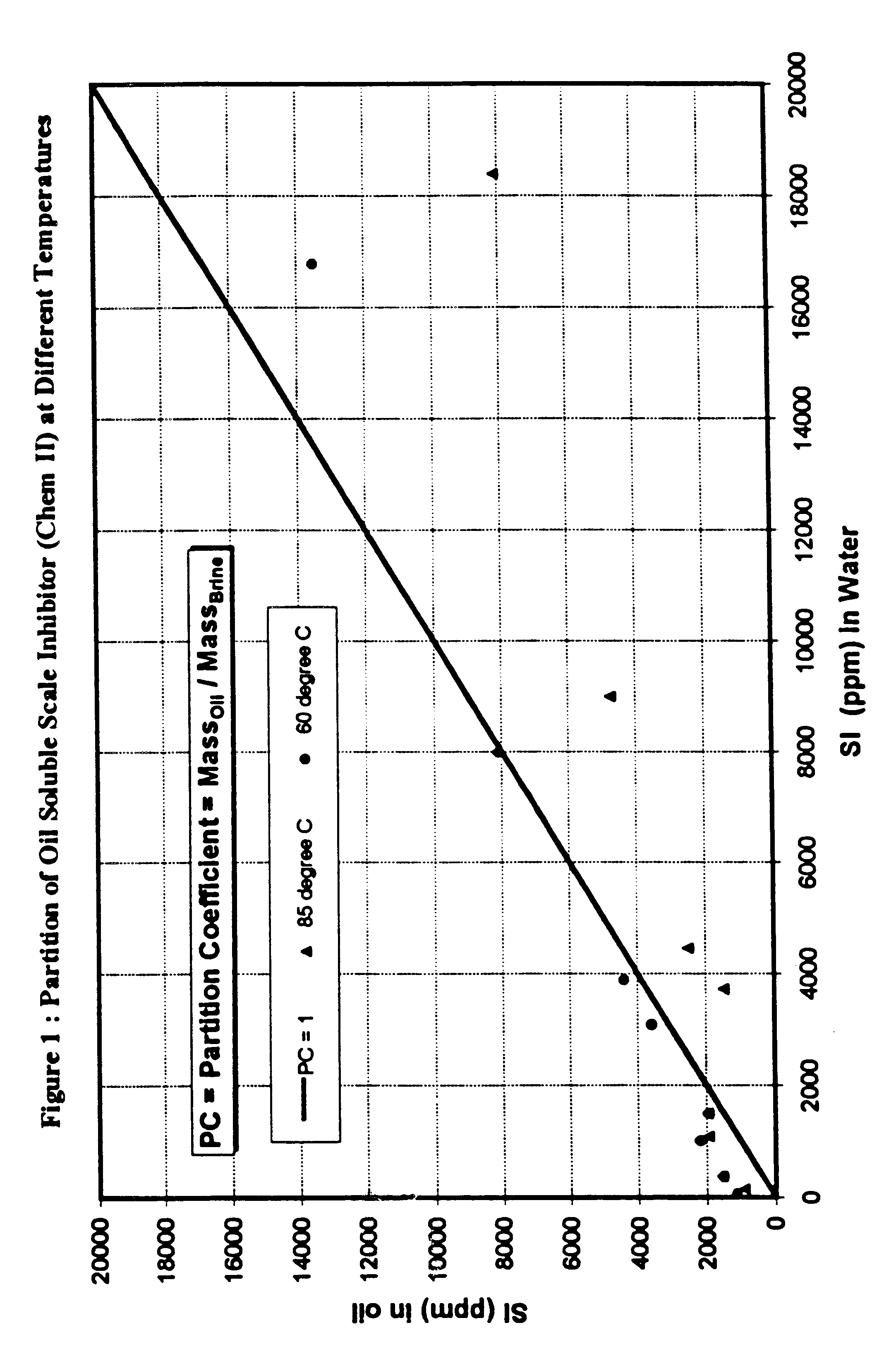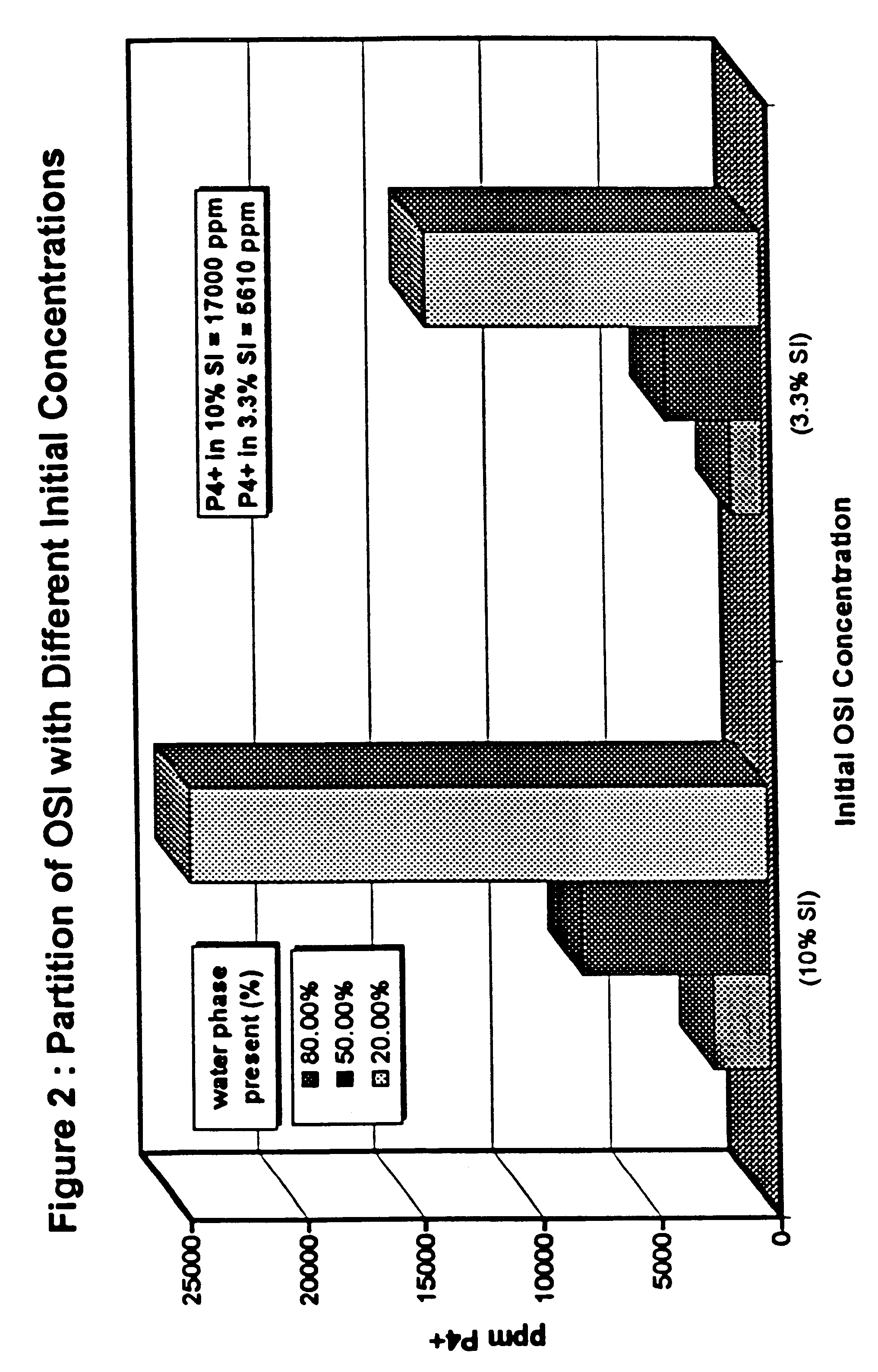Scale inhibitors
a technology of scale inhibitors and scale inhibitors, which is applied in the direction of chemistry apparatus and processes, cabinets, and well accessories, etc., can solve the problems of significant loss of production and associated revenue, large quantity of aqueous impurities becoming mixed, and scaling in any part of the production system
- Summary
- Abstract
- Description
- Claims
- Application Information
AI Technical Summary
Benefits of technology
Problems solved by technology
Method used
Image
Examples
example 1
Partitioning Mechanisms
Like the other mass transfer processes, the partition kinetics of the oil soluble scale inhibitor among the different phases will depend on a number of factors, such as the scale inhibitor type, the mixing regime, temperature, concentration gradient, contact time, brine composition and the type of hydrocarbon fluid.
The effect of temperature on the partition process is illustrated in FIG. 1. In this test a duplicate set of 8 oil soluble scale inhibitor samples, of various concentrations (1,400 ppm to 70,000 ppm), were mixed with Brine D (Table 2). The oil to brine ratio was kept at 1:3.4. One set of samples was heated to 60.degree. C. whilst a duplicated set was heated to 85.degree. C. The samples were shaken regularly and after overnight lock-in at temperature. The aqueous portions were drained off and analyzed for scale inhibitor concentration. It is clear from FIG. 1 that the amount of scale inhibitor partitioned in the water increased with temperature.
The e...
example 2
Scale inhibitor function
The next crucial question was whether the partitioned molecules behave like a "normal" scale inhibitor in preventing scale formation. FIGS. 3 to 8 show the results of dynamic tube blocking tests using Chem II diluted 50:50 with either HAN or base oil.
The dynamic tube blocking test is one of the standard procedures in checking scale inhibitor performance. If the inhibitor product is working and the dose rate is adequate it will stop scale deposit in the coil (tubing of 1 / 16" to 1 / 8" OD) which in turn will not cause pressure build-up. After first allowing the coil to prescale, causing an initial rise in pressure, the system is dosed with a known scale inhibitor concentration (normally in excess). The pressure will level off as deposition is stopped. The dose rate is then stepped back until the pressure shows sign of rising again. The minimum inhibition concentration (MIC) of the product is thus defined. Obviously the MIC value will vary with the type of brine (...
example 3
Multi-stage contact
Apart from inhibition performance, an oil soluble scale inhibitor must exhibit desorption characteristics similar to a water-based product in order to be considered for squeeze treatment.
It could be stated that the tests described above resemble only a single stage contact in the partition process and therefore that these results do not fully reflect the full mechanisms which will take place in real life. For example, in field applications, the oil soluble scale inhibitor is likely to be in continuous contact with fresh brine, e.g., the chemical front during a squeeze treatment. Whilst most of the inhibitor molecules will partition into the water phase on their first contact, some of them will remain in the oil phase.
In order to assess what would happen to inhibitor molecules remaining in the oil phase after the initial contact with aqueous phase and a multi-stage contact, a test was performed in which the oil soluble scale inhibitor was repeatedly mixed with fres...
PUM
| Property | Measurement | Unit |
|---|---|---|
| temperature | aaaaa | aaaaa |
| oil-soluble | aaaaa | aaaaa |
| pH | aaaaa | aaaaa |
Abstract
Description
Claims
Application Information
 Login to View More
Login to View More - R&D
- Intellectual Property
- Life Sciences
- Materials
- Tech Scout
- Unparalleled Data Quality
- Higher Quality Content
- 60% Fewer Hallucinations
Browse by: Latest US Patents, China's latest patents, Technical Efficacy Thesaurus, Application Domain, Technology Topic, Popular Technical Reports.
© 2025 PatSnap. All rights reserved.Legal|Privacy policy|Modern Slavery Act Transparency Statement|Sitemap|About US| Contact US: help@patsnap.com



